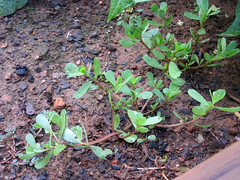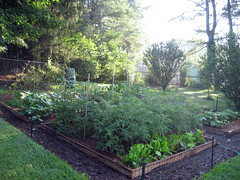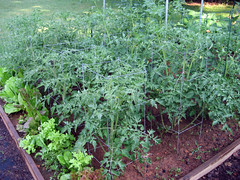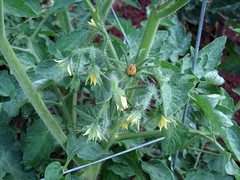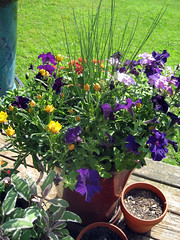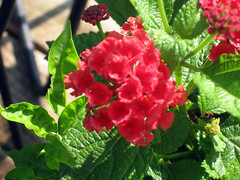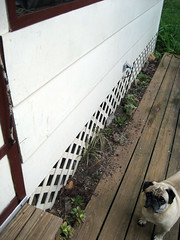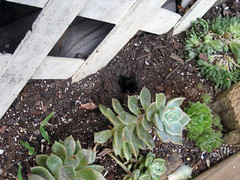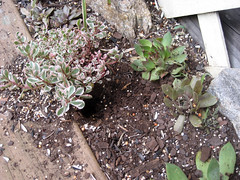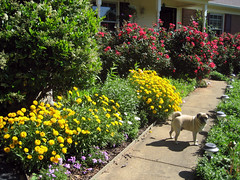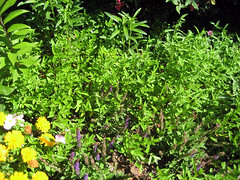After sowing the second round of corn to ensure a staggered harvest, the garden is finally filled to the brim.
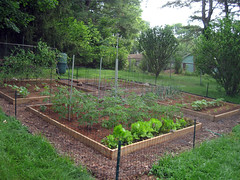
Gardening is considered a therapeutic hobby, but some of the challenges I faced with the tomatoes this year caused a little more
stress than stress
relief!
I always grow my tomatoes, eggplant and peppers from seed. This year I bought a seedling heat mat to speed up and increase germination rates and decided to install artificial overhead lighting to keep the tomatoes from getting leggy from leaning toward the window. When you sow seedlings indoors, the seed tray should be subjected to minimal light until the seedlings have broken through the soil. The tomatoes sprung up so quickly out of their warm peat pods that they were leggy from the start, stretching to reach the little bit of light provided from a nearby window while their eggplant and pepper counterparts remained asleep in their seed husks.
So I struggled with the tomatoes to strengthen their thin leggy stems for about 10 weeks. As it turns out, tomatoes aren't big fans of artificial light, especially the Marcellino, most of which were so pathetic looking that I couldn't possibly plant them in the garden. Adding to my frustrations, my attempts at moving the tomatoes around to find the optimal sun spot in the plant room resulted in the seedlings getting all mixed up, leaving me with no clue who was Marcellino and who was Costuloto. I had 10 of each and 16 spots in the garden, so the worst case scenario would end up with only 6 Marcellino in the garden and leave me with less salsa than planned. (I ended up with 7 Marcellino and 9 Costuloto - not bad!)
I did know definitively that a couple of the seedlings were Marcellino and I wanted to be sure to plant those in the garden. In my haste, I accidentally snipped one off in his peat pod, so I had to plunge his tiny little stem into the soil with no roots, hoping it would take hold. It did, but it's now my little runt. Grow little guy! Grow!
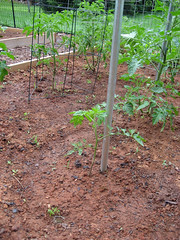
I decided to try cages this year since staking heirlooms like Costuloto proved a big hassle last year. I planned to stake the Marcellino (keeping them trained to one main stem) and cage the heirlooms since they are impossible to train to one main stem.
By training tomatoes to one main stem, the plant spends less energy producing leafy green branches and more time producing fruit. You get taller plants that are easier to keep staked since you don't have a lot of sprawling branches. My Marcellino generally grow to about 7' using this method.
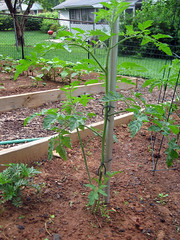
It takes a bit of persistence, but is otherwise simple. Just pinch off the extra branch that sprouts up between the main stem and a side branch. You have to keep on top of this chore though, as those little extraneous branches will keep growing back all season long!
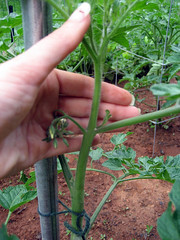
Unfortunately, the side shoots of three of the Marcellino got away from me while I was on vacation and now it is too late to keep them trained to one main stem, so I ended up caging them too. I guess we'll see if a Marcellino produces more fruit with one main stem or being treated like an heirloom. Let's not call it a mistake, but an experiment!
After finally getting all those little buggers healthy enough to plant and caging and staking them properly, I was faced with challenge number 3 - early blight.
Two years ago I grew 16 beautiful tomato plants with no sign of any sort of blight or yellowing of leaves. No problems with pests - nothing. They were just gorgeous. Last year the tomatoes were hit with tomato leaf roll, early blight and possibly some form of wilt. I chalked it up to not having rotated the planting site. Naughty gardener!
But this year has started off with signs of early blight already - black spots on the lower leaves caused by a fungus that is spread through air and soil.

Here are the steps to take to protect against
early blight:
- Always rotate crops from one year to the next
- Avoid overhead watering - I know - it's how God waters, but for some reason, we're not supposed to water like that
- Keep the lower branches of the plant pinched back to prevent soil from splashing up onto the plant during rainy weather
- Use a fungicide early and often throughout the growing season
- Pinch off any branches that have been affected by early blight - they won't get better and will only spread the fungus to neighboring branches
I recommend purchasing the fungicide spray in concentrate form and mixing it up yourself. I used one bottle on 8 plants last night, and once the plants get even more mature, that rate drops to one bottle per every 4 plants, which can get pricey!
The tomatoes may have caused me a bit of heartburn this year, but the crop is worth it. There is nothing as satisfying to a home gardener as a sweet juicy tomato fresh from the garden. I can't wait for July!
Labels: asheville, gardening, tomatoes, vegetables
